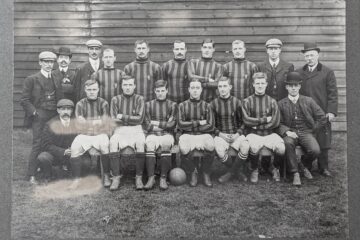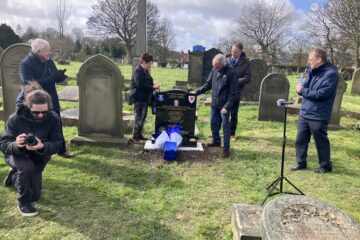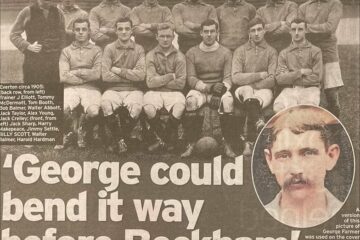
The clean-shaven young man, seated on the right of the middle row, is an eighteen-year-old player who had recently established himself in the first eleven of an Everton Football Club at the time of the photograph. As he gazes towards the camera and watches for the ‘birdie’, he is unaware that, in the course of the forthcoming football season, he will score the goal that will earn his club the right to lift their first piece of silverware. His football career, however, is destined to be cut short by injury.
William Henry Parry was born in 1864 in the north end of Liverpool. The 1881 census recorded that he was a son of Henry Parry who was a River Pilot and his Bristol-born wife, Ada. He had an elder sister, who was a teacher, and a younger brother, Frank, who was still at school. William, by then aged sixteen, listed his occupation as that of a Commercial Clerk. The family lived close to St Saviour’s church in Verger Street.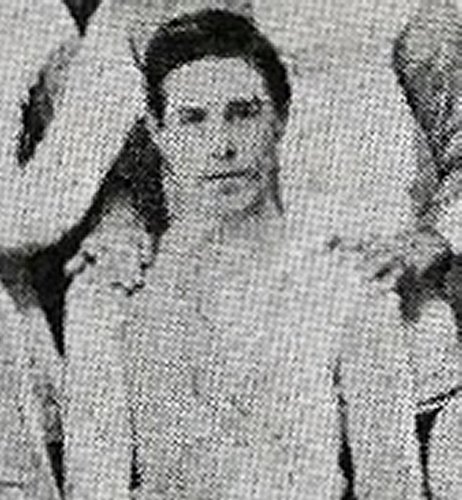
It is quite safe to assume that Parry was amongst the Liverpool pioneers of the new game, played under rules of the Football Association, who had begun to gather on Stanley Park to indulge themselves in this new past-time. Here he would have come under the tutelage of Tom Evans who would have helped him to improve his skills as a player. Parry next became a member of the recently-formed Everton Football Club, and made his debut for the second eleven sometime around the end of 1880. The young teenager impressed when, several weeks later, he made his first-team debut on Stanley Park. Parry, playing at half back, was mentioned in dispatches for his outstanding display against Garswood Park Colliery and helped Everton to achieve a 2-0 victory. Next season, as his game continued to improve, he established himself as a regular first-team player.
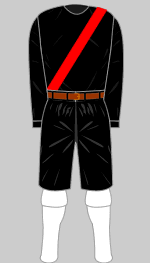 William Parry was in the Everton line up when they were first seen on Stanley Park wearing their now famous uniform of white shorts and a black shirt that was enhanced by a crimson diagonal sash. Their opponents, Chester Rovers, were beaten by three goals to nil. The club secretary, John W Clarke, then arranged for a visit to Stanley Park of the Cheshire Cup holders Northwich Victoria and Parry took part in the match. The occasion drew a hitherto unprecedented crowd of around 1,200 spectators to the location and they framed the playing area to watch an Everton side, who surprised their more experienced opponents, winning the game by two goals to nil.
William Parry was in the Everton line up when they were first seen on Stanley Park wearing their now famous uniform of white shorts and a black shirt that was enhanced by a crimson diagonal sash. Their opponents, Chester Rovers, were beaten by three goals to nil. The club secretary, John W Clarke, then arranged for a visit to Stanley Park of the Cheshire Cup holders Northwich Victoria and Parry took part in the match. The occasion drew a hitherto unprecedented crowd of around 1,200 spectators to the location and they framed the playing area to watch an Everton side, who surprised their more experienced opponents, winning the game by two goals to nil.
Parry next took part in a Lancashire FA Cup tie away at Turton on 10 December 1881, where Everton lost by 3 goals to 1. The next highlight of his career came in a ground-breaking game that was played in the neighbouring Borough of Bootle.
The local football club had constructed an enclosure made out of canvas on the cricket ground off Marsh Lane and they were asking for an admission fee to watch the game against Everton. Around five hundred people paid for the privilege to enter and watch William Parry take up position in the Everton half back line. The home side, having taken an early lead, were eventually beaten by four goals to one. Parry then played out the rest of the season with Everton before rejoining them, after the summer break, for what was to be their final season of playing football on Stanley Park. This year would also see the birth of a much-needed organisation, the Liverpool & District Football Association, which began operating in November 1882.
Everton, meanwhile, had again entered the Lancashire FA knockout and William Parry, along with his team mates, was about to find himself pitted against what was possibly the best side in the Kingdom. Their name was Blackburn Rovers and they were the holders of the Lancashire trophy. The east Lancashire club, who were now importing players from Scotland, had, at the beginning of the season, moved to a new purpose-built enclosure on Leamington Road. The club was going from strength to strength and the local population were quite prepared to pay the asking price to watch them perform.
There were around eight hundred present to watch the home side, in a one sided game, beat Everton by eight goals to nil. (The quality of this Blackburn side may be measured by the fact that, during the course of the season, they went on to retain the Lancashire trophy and also became the first team from the North of England to reach an FA Cup final.)
William Parry, none the worse for his ordeal, returned to playing football on Stanley Park and scored his first goal for Everton while playing away at Southport on the 23 December. He then scored again as Everton competed in their inaugural Liverpool Cup tie against the Liverpool Association at Walton Stiles. He later took part in the benchmark match played on Stanley Park against Bootle where the volume of the crowd overpowered the occasion and brought it to an unsatisfactory conclusion. Bootle, much to the chagrin of Everton, claimed to have won the game 1-0, while they claimed a draw. Parry, however, was injured in the game and missed the rest of a season that saw Everton, eliminated by Bootle, fail to lift the Liverpool Cup.
Nevertheless, he recovered from his injury and was back with the Everton club when they began life on their new enclosed ground on Priory Road. However, when the football season began, the location was still under construction, so the Everton players had a somewhat nomadic existence until it was ready to be opened in October, with a game that was to be played between a side selected from the member sides of the Liverpool FA and those from their counterparts at Walsall. William Parry took part in the game which ended in 3-3 draw, and then helped Everton to defeat a side from St Peters church in the first round of the Liverpool Cup. They then defeated Liverpool Ramblers and Bootle Wanderers to reach the final, where their opponents would be Earlestown.
The Lancashire town had grown in population around a large wagon-making works owned by the L&NW Railway Company, and the nearby Vulcan Foundry which made mobile steam locomotives. In 1884, the location had a population of around ten thousand people. Many had been drawn to the area to find employment in the engineering industry and, unlike their neighbours from the local coal mining communities, had chosen to follow the game played under the rules of the FA, as opposed to those of Rugby Public School. Earlestown were a formidable team of players who had already eliminated the previous holders of the trophy, Bootle.
They had recently become members of the Liverpool and District FA, and had reached the final of the local knockout tournament at their first attempt. The L&NW Railway Company, detecting the local interest, put on a special train that brought around five hundred Earlestown supporters to Liverpool, from where they would head to Bootle. (This was the first ever football special excursion to run in the Liverpool area).
The Liverpool FA had decided to stage the game on the new sport field that had opened the previous November on Hawthorne Road. Officially, this was the home of Bootle Cricket Club, who had agreed for a nominal rent, to share the ground with the local football club players. The ground was enclosed and around 2,500 were reported to have paid for admission delighting the local dignitaries connected to the Liverpool FA. The man placed in charge of the game was the Reverend C A Carter, curate of St Mary’s church in Kirkdale.
William Parry took up position at the centre of the Everton half back line as Earlestown set the game in motion. Everton, who began strongly, dominated the first moiety but, at half time, the score line was still blank. The second half had been in progress for twenty minutes when Edwin Berry, the Everton left back, broke away down the wing and centred the ball to his opponent’s goalmouth where a scrimmage occurred. The local newspaper reported that… At this critical juncture, Parry rushed up and shot the ball through the Earlestown uprights amidst tremendous cheering. Parry then had to endure a few moments of uncertainness because the Earlestown players appealed for offside but the Reverend Carter, who was not to be swayed, allowed the goal to stand.
This proved to be the only goal of game and, when the result became known, there was great rejoicing in Everton, the winning team being drawn in triumph through the streets. The trophy, it had been decided, was not to be awarded at the ground so the Everton players had to wait until the Liverpool FA AGM in June, before they could lay their hands on it. It was then displayed for the Everton members to view at the new headquarters of the club, The Sandon Hotel. The sight of the trophy, no doubt, filled them with pride and made them, as never before, to look forward to the next football season. This optimistic attitude proved to be vital because their favourite team was, momentarily, in danger of going out of business.

The club had recently been driven off the ground on Priory Road by their former Landlord and were now homeless. John Houlding, as we know, came to their aid and, thanks to his business acumen; a new enclosure was quickly erected on Anfield Road. The venue was opened with a match against Earlestown. Around 1,000 spectators, who had paid for admission, were present to witness the historic event and were pleased when the sides entered the enclosure to see Everton led out by their new club captain, William H Parry.
The Football League had yet to come in to being, so the most important mission, for Everton and their followers, continued to be the winning of the local knockout. They began the campaign with comfortable win over Toxteth Wanderers and this set up a mouth-watering tie against another football club who were making progress in the area, Bootle. The match took place in January 1885 at Anfield and it drew what was to date, the largest crowd to watch a football match on Merseyside.
There were three thousand people packed inside the simple Anfield enclosure to watch the two well matched sides play out a 0-0 draw. The game went in to extra time and then burst in to life. Bootle, who opened the scoring, held their lead for less then a minute before Whittle equalised for the home side. The match was nearing its conclusion when William Parry, standing outside the penalty area, fastened on to a clearance from the visitors defence and thumped the ball past the defenders to put Everton into the next round. Earlestown, with Bootle now out of the contest, were now the only strong side standing between Everton and the trophy. William Parry however, would take no further part in the tournament.
The Everton skipper next took his team of players across the River Mersey to take part in a fixture against Birkenhead on their open ground near to Woodside Ferry at Chester Street. The home side were leading 2-1 when, early in the second half, the Everton skipper…received a serious injury, inwardly, from a charge by one of home forwards. The game consequently, was discontinued and Parry had to be carried home. The injury, as feared, proved to be serious and he was never to be the same player again. Tom Marriott, the club full back, took over the club until Everton engaged the services of George Dobson.
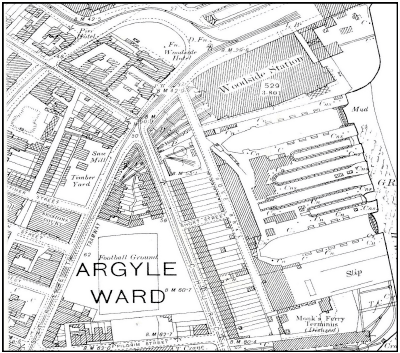
Will Parry attended the Liverpool Cup final, played again at Bootle, where he was forced to watch Earlestown beat Everton in a controversial game by one goal to nil. It was to be several months before he was again able, playing alongside his brother Frank, to represent Everton in a light-hearted club game that took place during the Christmas holiday. On 20 February 1886, Parry was selected to play for the Everton first X1 against the Welsh Druids at Anfield. However, he was injured early in the game and had to leave the field. He was out of the game until May, when he made a brief re-appearance in the Everton first eleven before retiring from the game. He then concentrated on his career.
In August 1889 William married Anne Elizabeth Smith of Salop Street in Liverpool. By the time of his marriage he was living at 16 Newlands Street and working as a book keeper. The ceremony took place at the church of St Mary in Kirkdale where the Reverend C A Carter, who took charge of the 1884 Liverpool Cup final, conducted the service. Frank Parry, the younger brother of William, was a witness to the event. The couple then set up home in Leopold Street off Kensington.
By 1901, William and Anne, with their ten-year-old son William, and daughter Louie aged five, had moved to 22 Langdale Road in Wavertree, where they were able to employ a female domestic servant. Ten years later the family and domestic servant had moved to 1 Gayton Road in Heswall on the Wirral and William Parry had qualified as a Chartered Accountant. By the thirties he had been elevated to the position of company director, and was residing in ‘Greystones’ in West Kirby.
This former Everton football player, whose goal won them their first trophy, later retired to North Wales where he passed away in Deganwy in March 1953.

